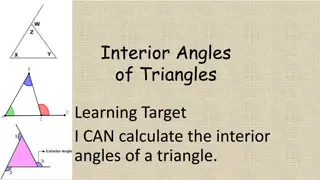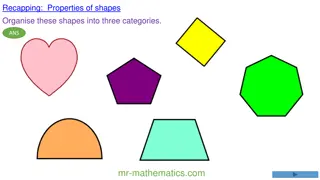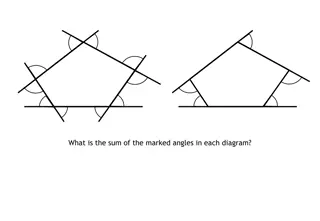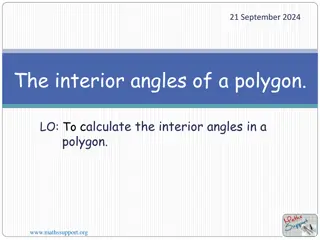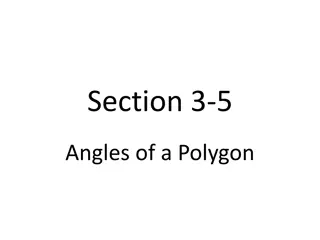Interior Angles of Polygons: Calculations and Examples
In this educational material, you will learn how to calculate the sum of interior angles in polygons such as hexagons and pentagons, determine the size of individual interior angles in regular polygons, and find the number of sides based on the sum of interior angles. Worked examples and practice questions are included to help you grasp these concepts effectively.
Uploaded on Apr 19, 2025 | 3 Views
Download Presentation

Please find below an Image/Link to download the presentation.
The content on the website is provided AS IS for your information and personal use only. It may not be sold, licensed, or shared on other websites without obtaining consent from the author.If you encounter any issues during the download, it is possible that the publisher has removed the file from their server.
You are allowed to download the files provided on this website for personal or commercial use, subject to the condition that they are used lawfully. All files are the property of their respective owners.
The content on the website is provided AS IS for your information and personal use only. It may not be sold, licensed, or shared on other websites without obtaining consent from the author.
E N D
Presentation Transcript
CSE 20: Discrete Mathematics for Computer Science Prof. Shachar Lovett
2 Today s Topics: 1. Recurrences 2. Example: amebas 3. Example: polygons
3 1. Recurrence Dominos tiling
4 Domino tiling A board with 2 rows and n columns How many ways can you tile it with 2x1 dominos (all identical)
5 Domino tiling Example: n=1 One way
6 Domino tiling Example: n=2 Two ways
7 Domino tiling Example: n=3 3 ways
8 Domino tiling Example: n=4 A. 3 ways B. 4 ways C. 5 ways D. 6 ways E. None of the above
9 Domino tiling Example: n=4 A. 3 ways B. 4 ways C. 5 ways D. 6 ways E. None of the above
10 Domino tiling Number of ways to tile an 2xn board with 1x2 and 2x1 domino pieces 1,2,3,5,8,13, Fibonacci sequence! Can we prove it? Try yourself first
11 Domino tiling P(n) number of ways to tile an 2xn board with 2x1 and 1x2 dominos Lets look on the right most tiles 2 x (n-1) board 2 x (n-2) board
12 Domino tiling 2 x (n-1) board 2 x (n-2) board 1st option: can tile remaining board in P(n-1) ways 2nd option: can tile remaining board in P(n-2) ways So P(n)=P(n-1)+P(n-2)
13 2. Amebas
14 Life-cycle of amebas Amebas multiply by splitting: creating two new amebas and dying immediately after Theorem: if you start with one ameba, then always the number of living amebas is one more than the number of dead amebas
15 Amebas Theorem: starting with one ameba, #living amebas = #dead amebas + 1 Definitions L(n) number of living amebas after n steps D(n) number of dead amebas after n steps Theorem: L(n)=D(n)+1 Try and prove yourself first (using induction)
16 Amebas Theorem: L(n)=D(n)+1 Proof by induction on n Base case: n=0, initially we have one living ameba and no dead amebas, so L(0)=1, D(0)=0 and L(0)=D(0)+1 Inductive case: Assume L(n)=D(n)+1. Prove for n+1. Going from time n to time n+1, we have one more living amebas and one more dead amebas, so L(n+1)=L(n)+1 and D(n+1)=D(n)+1, so also L(n+1)=D(n+1)+1. QED.
17 3. Geometry
18 Polygons Theorem: in a polygon with n sides, the sum of the interior angles is (n-2)180 Example: sum of angles is 3*180
19 Polygons Theorem: in a polygon with n sides, the sum of the interior angles is (n-2)180 Proof by induction on n Base case: A. n=1 B. n=2 C. n=3 D. n=4 E. Other
20 Polygons Theorem: in a polygon with n sides, the sum of the interior angles is (n-2)180 Proof by induction on n Base case: A. n=1 B. n=2 C. n=3 D. n=4 E. Other
21 Polygons Theorem: in a polygon with n sides, the sum of the interior angles is (n-2)180 Proof by induction on n Base case: n=3, sum of angles in a triangle is 180 (without proof here)
22 Polygons Theorem: in a polygon with n sides, the sum of the interior angles is (n-2)180 Inductive step: assume for n, prove for n+1 That is Assume: every n-polygon has degree sum (n-2)180 WTS: every (n+1)-polygon has degree sum (n-1)180
23 Polygons Theorem: in a polygon with n sides, the sum of the interior angles is (n-2)180 Inductive step: assume for n, prove for n+1 Main idea: split (n+1)-polygon to a triangle and an n-polygon Triangle, sum of angles is180 n-polygon, sum of angles is(n-2)180 by inductive hypothesis
24 Polygons Theorem: in a polygon with n sides, the sum of the interior angles is (n-2)180 Inductive step: assume for n, prove for n+1 Split the polygon by a diagonal to an n-polygon and a triangle. The sum of the angles in the (n+1)- polygon is equal to the sum of angles in the triangle plus the sum of the angles in the n-polygon. The sum of angles in the triangle is 180 . The sum of angles in the n-polygon is (n-2)180 by the inductive hypothesis. So, total sum of angles is (n-1) 180 . QED


